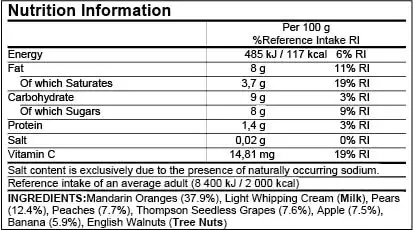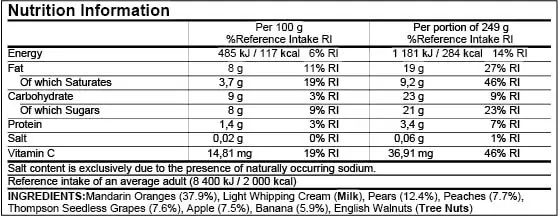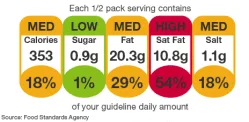For businesses in the food and beverage industry, nutrition labeling is of great importance when it comes to selling and marketing your products in the EU market. European nutrition labels are a way to present accurate and comprehensive information to consumers. Not only do they highlight the nutritional composition of food but they aim to help consumers make more informed decisions when it comes to their health and diet. The European Commission (EC) has set certain regulations for how EU nutrition labels should be presented on food packaging, and how this transparency and clear labeling best serves consumers. Labeling software can also assist businesses with the correct compliance steps and make their operations more efficient in the long run.
TLDR
- EU Nutrition Facts Labels Importance for Businesses: Nutrition labeling is crucial for selling and marketing products in the EU; provides accurate and comprehensive information; helps consumers make informed health and diet decisions; European Commission regulations ensure transparency and clear labeling; labeling software aids in compliance and operational efficiency.
- Types of Labels:
- Standard Nutrition Facts Label: Most used under current EU regulations; presented in a tabular format if space permits; must show energy (kJ and kcal), protein, fat, saturated fats, carbohydrates, sugars, and salt; optional nutrients and vitamins must be declared if health claims are made.
- Front-of-Pack Nutrition Label: Optional; provides a simplified overview; displays key info: energy, fat, saturated fat, sugars, carbohydrates, salt; uses indicators like Nutri-Score (A to E) and Traffic Light (green, amber, red) for easy understanding.
- Reference Intake Label: Optional; shows the nutrient contribution to daily intake; helps consumers understand nutritional content in the context of daily diet; may use traffic light color coding for readability.
- Choosing the Right Format:
- Standard Label: Required for EU compliance; detailed nutritional breakdown; no specific claims.
- Front-of-Pack: For quick consumption products; consumer-friendly; enhances product appeal.
- Reference Intake: For portion-specific info; improved readability; and voluntary use.
- Compliance Made Easy: Food Label Maker offers efficient software for creating compliant labels; features: automated, accurate, customizable, and updated for regulatory changes; supports EU, Mexican, and other international regulations.
EU Nutrition Templates
Standard Nutrition Facts Label
Under the current EU regulations, the Standard Nutrition Facts Label is used the most and is presented in a tabular format if there is enough space for it. The Standard Label is required to show mandatory nutritional information such as energy (in kJ and kcal), protein, fat, saturated fats (the portion of the total fat content that comes specifically from saturated fats), carbohydrates, sugars (the portion of the total carbohydrate content that comes from sugars) and salt.
If there are optional or additional nutrients that are consumed in large amounts, it should also be declared on the label. However, if a food product makes a nutrition or health claim related to Vitamin C for example, then it becomes compulsory to declare the amount of Vitamin C on the label. Additionally, manufacturers may voluntarily provide information about vitamins and minerals, including Vitamin C, as long as it is presented in a specific format and complies with the regulation’s requirements.



Front-of-Pack Nutrition Label
A Front-of-Pack (FoP) Nutrition Label is an optional label that has been designed to provide a simplified and easily understandable overview of the nutritional quality of food products. Regulation (EU) No 1169/2011 was introduced by the European Commission (EC) and outlines requirements for FOP labeling. It states that the label must display important nutrition information like energy, fat, saturated fat, sugars, carbohydrates, and salt. It is also a more simplified version than the Standard Nutrition Facts Label, giving a consumer more of a snapshot look at the nutrients in a food product.
It can also display indicators like the Nutri-Score, where food products are listed from A (healthiest) to E (least healthy), and using colors from green to red as shown below:

A Traffic Light indicator also uses color codes like green, amber, and red to indicate the levels of key nutrients like fat, saturated fat, sugars, and salt. This is displayed below:

This type of labeling helps consumers make healthier food choices quickly by presenting essential nutritional information in a concise and visually accessible format.
Reference Intake Label
A Reference Intake (RI) label, sometimes known as the Guideline Daily Amount (GDA) label, is an optional labeling system used in the EU that provides information on how much energy and specific nutrients are present in a portion of food and how they contribute to the recommended daily dietary intake for an average adult. This labeling format is designed to help consumers understand the nutritional content of their food in the context of their overall daily diet.
A RI Label is somewhat of a recommendation of what intake or threshold of nutrients an individual should consume. In some countries, this label uses color coding similar to a traffic light indicator. This is so that consumers can understand and easily see the level of healthy and unhealthy nutrients present in the food.
See How FoodLabelMaker Can Help You
Which Format Should You Use?
Standard Nutrition Facts Label
When to Use This Format:
- As a Regulatory Requirement: If your product is sold in the EU, you must include the Standard Nutrition Facts Label as per EU Regulation (EU) No 1169/2011. This label provides detailed nutritional information clearly, concisely, and effectively.
- Displaying Comprehensive Information: Use this format if you need to provide a complete nutritional breakdown, which is mandatory for all pre-packaged foods in the EU.
- Making No Specific Claims: If your product doesn’t make specific health or nutrition claims, the Standard Nutrition Facts Label is sufficient.
Front-of-Pack Nutrition Labeling
When to Use This Format:
- For Quick Reference: If your product is intended for quick consumption or is marketed as a healthy option (e.g., snacks, ready-to-eat meals), consider using Front-of-Pack (FoP) labeling.
- As a Consumer-Friendly Option: Use this format to help consumers make healthier choices at a glance, especially when using indicators like Nutri-Score or Traffic Light labels.
- Optional but Beneficial Use: While not mandatory, FoP labels can enhance your product’s appeal by displaying an easy-to-understand summary of nutritional quality.
Reference Intake (RI) Label
When to Use This Format:
- For Portion-Specific Information: If you want to show how a portion of your food contributes to daily dietary intake, the Reference Intake (RI) label is ideal. It is particularly useful for products with variable serving sizes.
- Enhanced Readability: In some countries, adding color-coding to the RI label can improve consumer understanding and readability so that it’s easier for them to gauge the nutritional impact of a single serving.
- Only Required For Voluntary Use: RI labels are not compulsory but can be a great addition to your packaging if you want to provide clear and concise nutritional information for your consumers.
Easy Compliance
Platforms like Food Label Maker offer efficient nutrition label software that makes compliance with current EU nutrition label regulations effortless. They offer many features that are designed to streamline your business processes and quicken operations. The automated platform reduces manual input and the errors that come with it, ensuring that your labels are both accurate and scalable. Its user-friendly platform makes creating compliant labels a breeze, while extensive customization options can suit your brand’s individual style and needs.
They also undergo continuous updates and monitor the market to reflect the latest regulatory changes. This is so that you always stay ahead of competitors and be confident that your labels will always meet current and evolving EU label standards. Whether you need to adhere to EU, Mexican, or other international regulations, Food Label Maker can help you make compliance straightforward and stress-free.
Conclusion
Ensuring that your food product has the correct EU nutrition label is not only important for compliance reasons but also for your consumer. It is a way to concisely and effectively state the nutrient contents of your product while giving a customer the agency to make more informed and healthier choices when it comes to what they buy and consume.
Platforms like Food Label Maker offer solutions that simplify the compliance process with European nutrition labels while ensuring your products meet all necessary requirements. For more detailed guidance and to explore our comprehensive labeling solutions, download Food Label Maker’s helpful templates or contact us for more information. Let Food Label Maker help you achieve seamless compliance with food labeling regulations.



